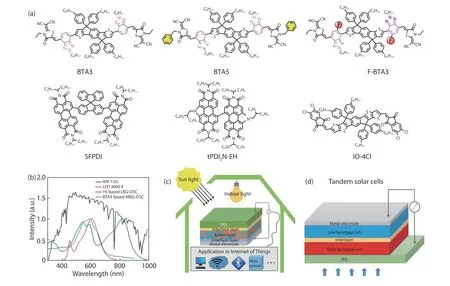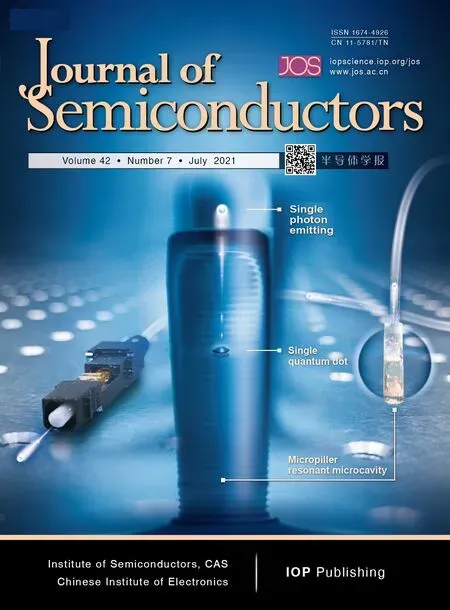~1.2 V open-circuit voltage from organic solar cells
Ailing Tang, Zuo Xiao, Liming Ding, , and Erjun Zhou,
1Center for Excellence in Nanoscience (CAS), Key Laboratory of Nanosystem and Hierarchical Fabrication (CAS), National Center for Nanoscience and Technology, Beijing 100190, China
2Henan Institute of Advanced Technology, Zhengzhou University, Zhengzhou 450003, China
Organic solar cells (OSCs) have achieved rapid advance due to the continuous development of high-performance key materials. Recently, the power conversion efficiencies (PCEs)of OSCs under 1 Sun condition (AM 1.5 G, 100 mW/cm2) are striving toward 19%[1-5]. The PCE improvement benefits from the largely enhanced short-circuit current density (Jsc) and fill factor (FF). However, these cells show relatively low opencircuit voltage (Voc) around 0.8-0.9 V. The rise of Internet of Things (IoT) industry has promoted the indoor application of solar cells. OSCs can afford higher PCEs under various indoor light as compared to 1 Sun condition[6,7], but they present lower Voc[8]. Fabricating tandem devices is an effective strategy to boost the performance of OSCs. Sub-cells with synchronously high Voc, Jscand FF are highly desired in tandem cells, while these sub-cells are still limited[9]. Thus, improving Vocwithout sacrificing Jscand FF is an urgent mission in OSCs.
Vocis closely related to the energy gap between the highest occupied molecular orbital (HOMO) level of the donor (D) and the lowest unoccupied molecular orbital(LUMO) level of the acceptor (A)[10,11]. By careful controlling the energy levels, single-junction OSCs can give high Voc, as well as high PCEs. Fig. 1(a) summarizes the nonfullerene acceptors (NFAs) used in high-voltage (~1.2 V) and high-efficiency (>6%) OSCs, and the performance data are listed in Table 1. The benzotriazole (BTA)-based A2-A1-D-A1-A2type NFAs developed by Zhou et al. yielded high-voltage OSCs.These molecules consist of an indenodithiophene core, BTA bridges, and (1,1-dicyanomethylene)rhodanine terminal groups. They used a “Same-A-Strategy” (SAS) to design efficient donor/acceptor combinations. The D-A copolymers based on BTA unit are chosen as the donors to pair with the BTA-based acceptors, producing a series of high-voltage OSCs (~1.20 V)[12-18]. For example, the acceptor BTA3 with a high-lying LUMO level (~-3.7 eV) and a wide optical bandgap(~1.80 eV) matches well with the copolymer donor J52-Cl with a fluorinated BTA unit[14]. The resulting cells gave a Vocof 1.24 V with a PCE of 10.5%, which is a breakthrough for OSCs with Voc> 1.20 V. PfBTAZT-Cl with thiophene-fused BTA unit (fBTAZT) offered a Vocof 1.20 V with a PCE of 8.00%[16].BTA5 with benzyl-substituted end groups shows an A2-A2packing and realized an improved PCE of 11.3%[15]. By introducing fluorine atoms, the resulted F-BTA3 achieved a PCE of 8.38% with a Vocof 1.25 V, when blending with a pyrrolo[3, 4-f]benzotriazole-5,7-dione (TzBI)-based polymer donor[18].Zhou et al. studied related charge generation mechanism in these high-voltage OSCs[21]. They found that a driving force of 0.2-0.3 eV is required for efficient charge generation.When below that value, the charge generation efficiency could drop and become electric field-dependent. Perylene diimide (PDI)-based NFAs are another type of acceptors for high-voltage OSCs. Duan et al. chose spirofluorene as a bridge to link two PDI units and synthesized the dimer SFPDI[19]. BDT-ffBX-DT:SFPDI solar cells offered a Vocof 1.23 V and a PCE of 6.2%. Welch et al. synthesized a twisted N-annulated PDI dimer (tPDI2N-EH) and realized a Vocof 1.22 V when using PTQ10 as the donor[20]. Hou et al. made IO-4Cl by replacing the CN groups in ITIC-4Cl with carbonyl groups[6]. PBDBTF:IO-4Cl cells achieved a Vocof 1.24 V with a PCE of 9.8%.These cells still gave Vocaround 1.10 V and PCEs over 26% under indoor light.

Table 1. Detailed parameters for OSCs with ~1.2 V Voc and >6% PCEs.
High-VocOSCs are advancing via the innovative design of NFAs and copolymer donors. The blends with bandgaps around 1.8-1.9 eV match the indoor light (Fig. 1(b)). A recent theoretical study indicates that a maximum efficiency of 52%is achievable under indoor light[22]. Materials that can offer synchronously high Voc, Jscand FF are quite limited. To make highly efficient indoor and tandem OSCs (Figs. 1(c) and 1(d)),more high-performance OSC materials are required.

Fig. 1. (Color online) (a) The chemical structures for NFAs with ~1.2 V Voc and > 6% PCE. (b) Solar spectrum, emission spectrum of LED 3000 K and the spectral response for Y6-based low-bandgap OSC and BTA3-based wide-bandgap OSC. (c) The high-voltage OSCs under sun light or indoor light. (d) Application in tandem structure.
Acknowledgements
This work was supported by the National Key Research and Development Program of China (2017YFA0206600), the National Natural Science Foundation of China (51773045,21772030, 51922032, 21961160720, 21875052, 51873044 and 52073067) and the Key Research Program of Frontier Sciences (CAS) (QYZDB-SSW-SLH033).
 Journal of Semiconductors2021年7期
Journal of Semiconductors2021年7期
- Journal of Semiconductors的其它文章
- Fabrication, characterization, numerical simulation and compact modeling of P3HT based organic thin film transistors
- The investigation of DARC etch back in DRAM capacitor oxide mask opening
- Fiber coupled high count-rate single-photon generated from InAs quantum dots
- Structural and electrical characterization of Cu2ZnSnS4 ingot material grown by melting method
- High room-temperature magnetization in Co-doped TiO2 nanoparticles promoted by vacuum annealing for different durations
- A15 Gbps-NRZ, 30 Gbps-PAM4, 120 mA laser diode driver implemented in 0.15-μm GaAs E-mode pHEMT technology
